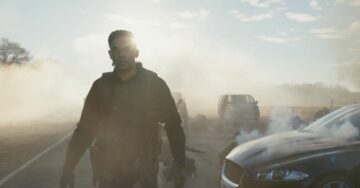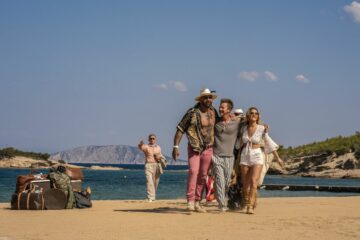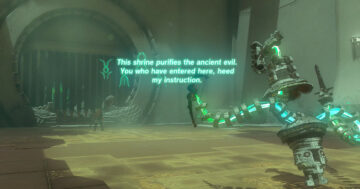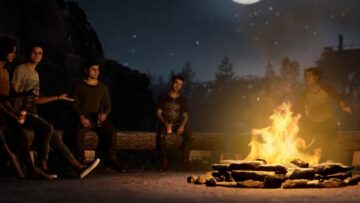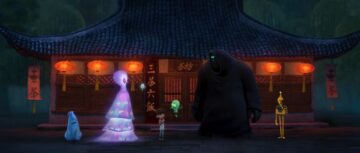After making several memorable appearances in The Wheel of Time season 2’s first four installments, the Prime Video series’ Seanchan invaders finally take center stage in episode 5, “Damane.” They make the most of it, too, showing off everything from their culture and politics to their fashion over the course of the episode’s hour run time. What’s more, “Damane” also hammers home what Wheel of Time’s second season has already made abundantly clear: The Seanchan are a major threat, and one whose motivations hit closer to home than your standard fantasy army with world conquest in its sights.
[Ed. note: This post contains spoilers for The Wheel of Time season 2, episode 5.]
Of course, the Seanchan do want to conquer the world, and — based on the raspy proclamations of Daniel Francis’ High Lord Turak — they don’t care who knows it. So it would be easy to write them off as one more made-up military power bent on global domination. And to an extent that’s true, as producer Holger Reibiger acknowledged during Polygon’s recent Wheel of Time set visit. Reibiger describes the Seanchan as “evil” and “a new darkness,” which positions them as broadly in the same camp as the merciless minions of Mordor in another Amazon Studios production, The Lord of the Rings: The Rings of Power.
However, that’s not the full story, and why the Seanchan have decided the Wheel of Time universe would be better off with them in charge is where things get more interesting — not to mention scarier. The Seanchan aren’t trying to run the show simply because they want to, but because they believe they have to. As dialogue in “Damane” hints at, just like in author Robert Jordan’s original Wheel of Time novels, these folks grew up being told it was their manifest destiny to rule the lands across the sea. Armed with this ruthless, self-assured conviction, they embody the very worst aspects of colonialism and exceptionalism, and that makes them just as dangerous as the Dark One’s Trolloc hordes.
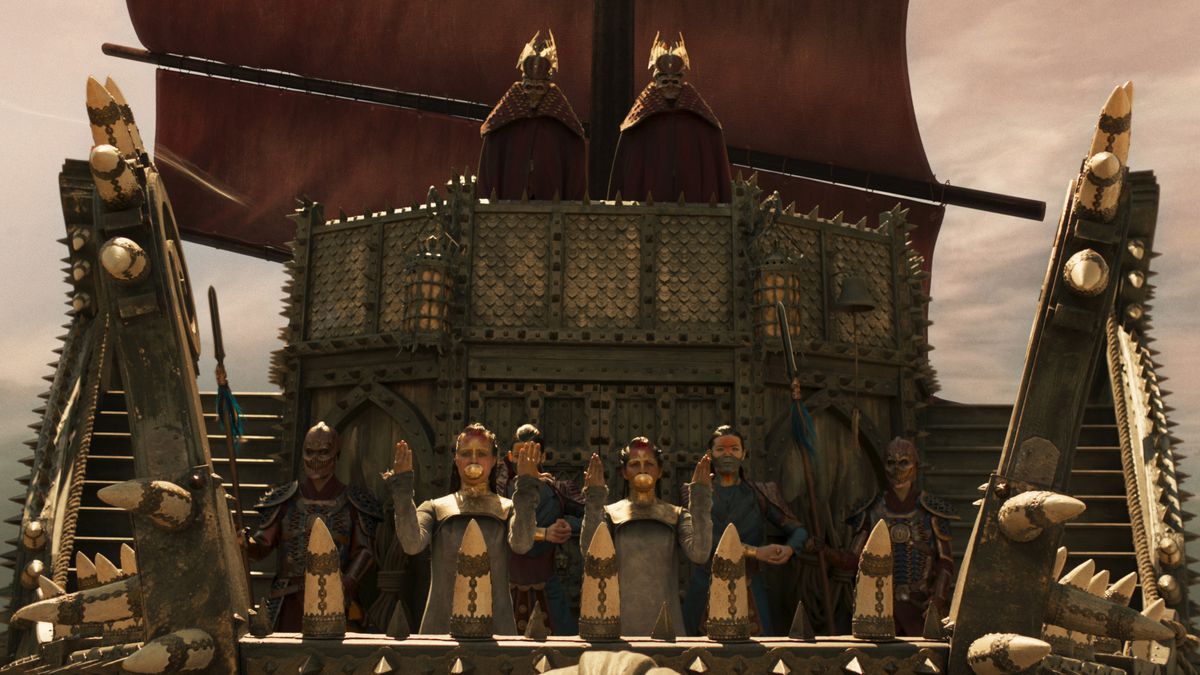
This reading is backed up by one of The Wheel of Time season 2’s directors, Sanaa Hamri, who draws direct parallels between the fictional Seanchan and various empires throughout history. “First and foremost, we’re in a world that is very special in Wheel of Time, where the women wield the power. […] The Seanchan come and invade like colonial powers and take that power away,” she says. “And I think that is the big symbol of themes we’ve dealt with as humans on Earth as well as in the show.”
Hamri wasn’t the only member of the crew keen to lean into the Seanchan-as-colonizers take, either. Showrunner Rafe Judkins was also keen to play up this association, according to costume designer Sharon Gilham. “One of the things Rafe said [when discussing the Seanchan] is, it’s like when the first settlers came to the New World, and it’s that sort of [reaction] like, What is that thing I’ve never seen before?” Gilham added that she herself wanted to include visual cues to another of the Seanchan’s colonialist red flags — the slavery rampant in their empire — in the design of subjugated female channelers the damane.
“The damane have these gold mouth stoppers; that’s not in the books,” she says. “But when I was doing my research, one of the things I came across in pre-Aztec research information was an actual image of a big gold stopper, and I thought that was really cool. And it also suggests that the damane have been silenced and they are the slaves.”
The moral surety with which the Seanchan gag and collar Egwene al’Vere (Madeleine Madden) and other women who can wield the One Power is just one way their exceptionalism presents itself. After all, you don’t force someone to wear a leash and parade them around in public if you consider them an equal. Others are subtler, but no less insidious.
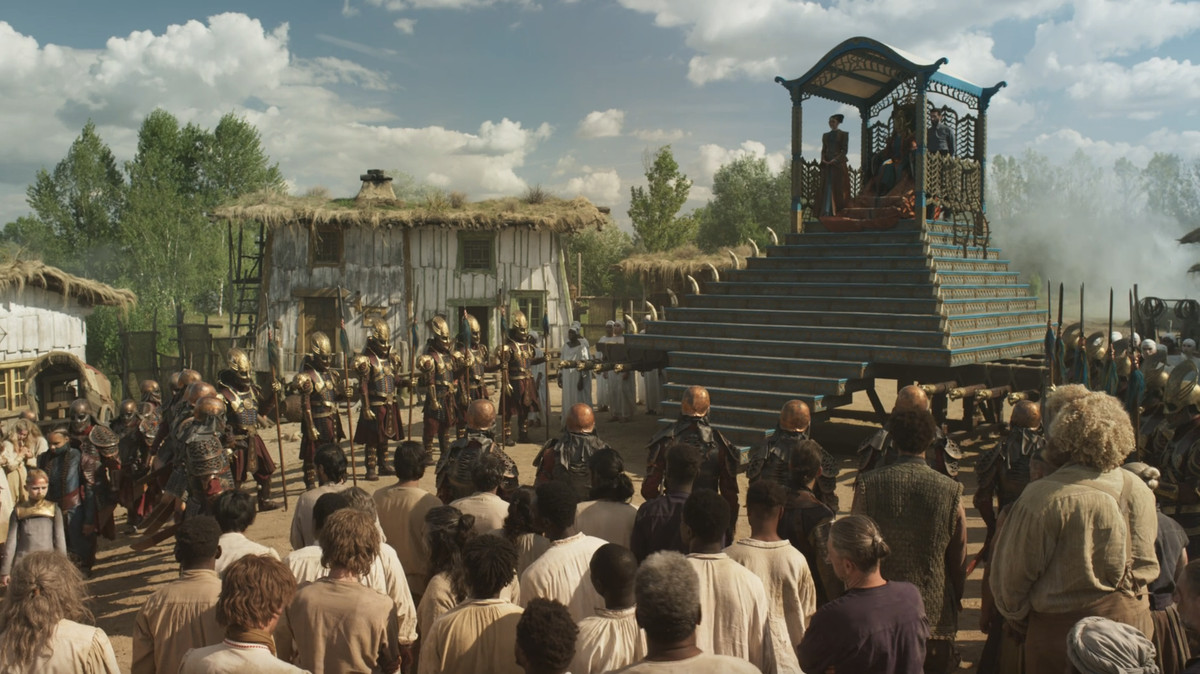
Take the supposed omens that steered the Seanchan invasion mentioned in The Wheel of Time season 2’s fifth episode — what is that if not their version of being guided (and endorsed by) the divine? Then there’s the structure of Seanchan society itself, which is presided over by the Blood. Distinguished by their shaved heads and scandalously long fingernails, the Blood are for the most part those directly related to the empire’s founder, Luthair Paendrag Mondwin, and his original armies — but they do occasionally elevate commoners to their level. In practice, this means the Seanchan way of life is built upon the idea that the closer you are to being considered OG Seanchan, the more entitled you are to exert influence over those around you (and by extension, the world at large).
(Incidentally, the oversized fingernails Turak and Karima McAdams’ Lady Suroth rock in Wheel of Time season 2 were as much of a logistical headache as you’d expect where choreographing sword fights was concerned: “We did a lot of practice,” admits stunt coordinator Jan Petrina, with a grin.)
So, what does all this talk of Seanchan colonialism and exceptionalism mean for The Wheel of Time season 2’s three remaining episodes? Well, episode 5 seemingly removes any doubt that this season is headed toward a showdown between the Seanchan forces and series protagonist Rand al’Thor (Josha Stradowski) and his allies, as described in Jordan’s second book, The Great Hunt. As such, viewers should expect the Seanchan to respond to the first real challenge to their dogmatic empire-expansion plans with gusto.
And no matter whether the Seanchan emerge as winners or losers, history (and Jordan’s canon) suggests that, like all colonizers, they’re unlikely to rethink the whole “rule the world” thing in future seasons. Why would they? After all, it’s their right.
- SEO Powered Content & PR Distribution. Get Amplified Today.
- PlatoData.Network Vertical Generative Ai. Empower Yourself. Access Here.
- PlatoAiStream. Web3 Intelligence. Knowledge Amplified. Access Here.
- PlatoESG. Automotive / EVs, Carbon, CleanTech, Energy, Environment, Solar, Waste Management. Access Here.
- PlatoHealth. Biotech and Clinical Trials Intelligence. Access Here.
- ChartPrime. Elevate your Trading Game with ChartPrime. Access Here.
- BlockOffsets. Modernizing Environmental Offset Ownership. Access Here.
- Source: https://www.polygon.com/23873981/wheel-of-time-season-2-seanchan-bad-guys-explained
- :has
- :is
- :not
- :where
- $UP
- 3000
- a
- According
- acknowledged
- across
- actual
- added
- After
- All
- already
- also
- Amazon
- an
- and
- Another
- any
- appearances
- ARE
- armed
- Army
- around
- AS
- aspects
- Association
- At
- author
- away
- backed
- based
- BE
- because
- been
- before
- being
- believe
- Better
- between
- Big
- blood
- book
- Books
- broadly
- built
- but
- by
- came
- Camp
- CAN
- captured
- care
- Center
- center stage
- challenge
- charge
- clear
- closer
- come
- concerned
- Consider
- considered
- contains
- conviction
- Cool
- Coordinator
- course
- Culture
- Dangerous
- Daniel
- dealt
- decided
- described
- Design
- Designer
- dialogue
- DID
- direct
- directly
- Directors
- discussing
- Distinguished
- do
- does
- doing
- Dont
- doubt
- draws
- during
- earth
- easy
- either
- ELEVATE
- emerge
- Empire
- entitled
- episode
- Episodes
- equal
- Ether (ETH)
- everything
- expect
- extension
- extent
- FANTASY
- far
- Fashion
- female
- fictional
- fifth
- fights
- Finally
- First
- flags
- For
- Force
- Forces
- foremost
- founder
- four
- from
- front
- full
- future
- get
- Global
- Gold
- good
- great
- grew
- grin
- guided
- Gusto
- Have
- headed
- heads
- her
- High
- hints
- his
- history
- Hit
- Home
- hour
- HTTPS
- Humans
- i
- idea
- if
- image
- in
- include
- influence
- information
- interesting
- into
- Invade
- invasion
- IT
- ITS
- itself
- Jan
- jpg
- just
- just one
- Keen
- lady
- lands
- large
- leader
- less
- Level
- Life
- like
- Long
- Losers
- Lot
- made
- major
- make
- MAKES
- Making
- Matter
- mean
- means
- member
- memorable
- mention
- mentioned
- merciless
- Military
- moral
- more
- most
- motivations
- mouth
- much
- my
- never
- New
- no
- note
- occasionally
- of
- off
- on
- ONE
- only
- or
- original
- Other
- Others
- over
- Parallels
- part
- plans
- plato
- Plato Data Intelligence
- PlatoData
- Play
- politics
- Polygon
- Polygon’s
- positions
- Post
- power
- powers
- practice
- presents
- Prime
- producer
- Production
- protagonist
- public
- Pyramid
- rand
- reaction
- Reading
- real
- really
- reason
- recent
- Red
- Red Flags
- related
- remaining
- research
- Respond
- ROBERT
- Rock
- Rule
- Run
- Said
- same
- says
- SEA
- Season
- seasons
- Second
- seemingly
- seen
- Series
- several
- she
- shot
- should
- show
- Showdown
- showing
- Sights
- simply
- Sitting
- So
- Society
- Someone
- special
- Stage
- standard
- Story
- structure
- studios
- such
- Suggests
- supposed
- Surrounding
- symbol
- Take
- Talk
- than
- that
- The
- the world
- their
- Them
- themes
- then
- These
- they
- thing
- things
- Think
- this
- those
- thought
- threat
- three
- throughout
- time
- to
- told
- too
- toward
- true
- trying
- unlikely
- upon
- various
- version
- very
- Video
- viewers
- Village
- Visit
- want
- wanted
- was
- Way..
- webp
- WELL
- were
- What
- What is
- Wheel
- when
- whether
- which
- WHO
- whole
- whose
- why
- wield
- winners
- with
- Women
- world
- Worst
- would
- write
- you
- Your
- zephyrnet

